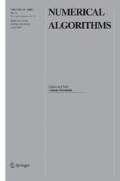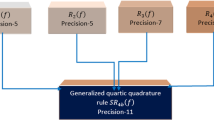Abstract
Quadrature rules are typically derived by requiring that all polynomials of a certain degree be integrated exactly. The nonstandard issue discussed here is the requirement that, in addition to the polynomials, the rule also integrates a set of prescribed rational functions exactly. Recurrence formulas for computing such quadrature rules are derived. In addition, Fejér's first rule, which is based on polynomial interpolation at Chebyshev nodes, is extended to integrate also rational functions with pre-assigned poles exactly. Numerical results, showing a favorable comparison with similar rules that have been proposed in the literature, are presented. An error analysis of a representative test problem is given.
Similar content being viewed by others
References
M. Branders and R. Piessens, An extension of Clenshaw-Curtis quadrature, J. Comput. Appl. Math. 1 (1975) 55–65.
F. Cala Rodriguez, R. Gonzalez-Vera and M. Jimenez Paiz, Quadrature formulas for rational functions, to appear in Electron. Trans. Numer. Anal.
P.J. Davis and P. Rabinowitz, Methods of Numerical Integration, 2nd ed. (Academic Press, New York, 1984).
W. Gautschi, Gauss-type quadrature rules for rational functions, in: Numerical Integration IV, eds. H. Brass and G. Hämmerlin, International Series of Numerical Mathematics, Vol. 112 (Birkhäuser, Basel, 1993) pp. 111–130.
W. Gautschi, Algorithm xxx: GQRAT-Gauss quadrature for rational functions, to appear in ACM Trans. Math. Software.
P. González-Vera, M. Jiménez Paiz, R. Orive and G. López Lagomasino, On the convergence of quadrature formulas connected with multipoint Padé-type approximation, J. Math. Anal. Appl. 202 (1996) 747–775.
N.J. Higham, The accuracy of floating point summation, SIAM J. Sci. Comput. 14 (1993) 783–799.
V.I. Krylov, Approximate Calculation of Integrals (Macmillan, New York, 1962).
F.W.J. Olver, Numerical solution of second-order linear difference equations, J. Res. NBS B 71 (1967) 111–129.
R.A. Sack and A.F. Donovan, An algorithm for Gaussian quadrature given modified moments, Numer. Math. 18 (1972) 465–478.
W. Van Assche and I. Vanherwegen, Quadrature formulas based on rational interpolation, Math. Comp. 61 (1993) 765–783.
J.C. Wheeler, Modified moments and Gaussian quadratures, Rocky Mountain J. Math. 4 (1974) 287–296.
Author information
Authors and Affiliations
Rights and permissions
About this article
Cite this article
Weideman, J., Laurie, D. Quadrature rules based on partial fraction expansions. Numerical Algorithms 24, 159–178 (2000). https://doi.org/10.1023/A:1019145327098
Issue Date:
DOI: https://doi.org/10.1023/A:1019145327098



